Special Online companion piece to LA Weekly’s Brentwood’s Toxic Grave and EnviroReporter.com’s Atomic Tombstones
They’re not supposed to be there. Gregory. William. Philip. Joseph. It’s not that they died too young, or unfairly. We don’t know how these veterans died, only that they did, and that they deserve the respect and honor due to any of America’s men and women in uniform.
But dignity is not a word that comes to mind looking at their gravestones, which once graced Los Angeles National Cemetery. Now they lie broken and discarded among the remnants of the West LA VA’s forgotten biomedical nuclear and chemical dump.
Veterans’ tombstones are replaced when a spouse dies and is added to the grave, therefore added to the gravestone, or when the stones are cracked, unsightly or present a hazard. VA regulations are explicit that all veteran tombstones removed from national cemeteries, here and elsewhere, must be destroyed with the names no longer visible.
But, as exposed in the LA Weekly piece “Brentwood’s Toxic Grave” and EnviroReporter.com‘s “Atomic Tombstones,” at the West Los Angeles VA, regulations – like the soldiers’ gravestones – are tossed off with reckless impunity.
Critics contend that veterans’ needs are continually deep-sixed by the VA. “First of all, you have a picture of a veteran sleeping outside the gate of 399 acres of which they are doing filming,” says Jay Handal, chairman of the West Los Angeles Neighborhood Council and owner of the San Gennaro Café in Brentwood Village. “They would rather store trucks and buses and cars than house their homeless veterans. What’s wrong with that picture? What’s wrong with our government’s priorities?”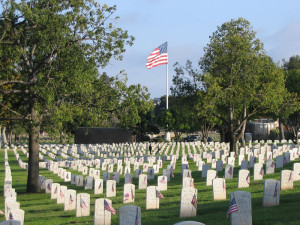
The West LA VA is the most valuable underdeveloped metropolitan federal land in country. It was deeded to the government in 1888 to be permanently maintained as a soldiers’ home. But even with unprecedented numbers of veterans returning from Iraq and Afghanistan, and a December 2007 law designed to protect the land championed by Sen. Diane Feinstein (D-California); the property is flagrantly exploited and neglected.
Families of veterans live in RVs on campus or along San Vicente Boulevard in Brentwood, while dozens of sub-contractors such as Fox, Marriott, Enterprise Rent-a-car, the Los Angeles Times, Kenwood Vineyards, Brietburn Energy, and Brentwood School profit from the land.
Veterans protest weekly over a new 16-acre public “Veterans’ Park” that will be built on $500 million worth of the property at the corner of the most congested intersections in the city, Wilshire and San Vicente boulevards. The park, critics say, is payoff to Brentwood’s well-connected for fighting the Bush administration’s controversial CARES plan to develop the VA property. That plan to commercially develop vast swaths of the VA, including where the dump area is, was defeated in September 2007, in part because of EnviroReporter.com‘s revelations about the toxic waste site. It was at that time that the VA also committed to a $1 million Phase Two testing of the site as reiterated by West LA VA honcho Ralph Tillman on KCET’s “Life & Times” program December 19, 2007.
These atomic tombstones may have become a metaphor for what veterans and community activists alike assert about the people in charge of the West LA VA: Rules aren’t being followed and there isn’t enough respect and services given the veterans who are alive.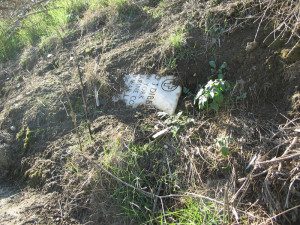
The soldiers’ tombstones, which number at least ten, have sat in sight of thousands of kids playing soccer on adjacent MacArthur Field since at least January 9, 2008, when EnviroReporter.com first spotted them.
This reporter told U.S. Senator Feinstein and Trevor Daley, her district director, about them a week later and offered to show them the ghoulish graveyard. That was nearly two years ago. Recent phone calls to the Senator’s office have gone unreturned.
The veterans’ tombstones are lying out in the open right now while VA contractors go about their business coring the dump for contamination in the questionable places as part of the second phase of testing the dump.
The atomic tombstones take the sordid history of Brentwood’s nuclear and chemical dump to new depths. Military tombstone scandals, however, aren’t confined to the West LA VA.
In March of 2008, in a New Jersey suburb outside of Philadelphia, it was revealed that hundreds of soldiers’ tombstones had somehow found their way to a Burlington Township home seven miles away from Beverly National Cemetery where they originated.
The tombstones, some dating back to Spanish American War and weighing 230 pounds apiece, were used as landscaping and for a border around a yard along Columbus Road.
The U.S. Department of Veterans Affairs Office of Inspector General and the U.S. Attorney’s Office for the District of New Jersey, warrant in hand, raided the property and hauled away the gravestones in a dump truck. A VA spokeswoman said that the tombstones should have been destroyed so they couldn’t be reused. Investigators offered the media a hot line number to Beverly National Cemetery to call in case the public saw any instances of tombstones being used improperly.
Early last April, CBS Channel 8 out of Las Vegas Nevada broke a story called “State Workers Use Old Vet’s Headstones for Patio.” According to the station’s “I-Team” coverage which included a disguised informant who feared for his safety and helicopter surveillance, two VA employees took 77 veterans’ tombstones from the Boulder City Veteran’s Cemetery, each weighing 130 pounds, and used them to build an outdoor patio.
Tami and Kevin Jenicke at first fudged on whether they even knew that their patio was made of tombstones, even though Kevin works at the cemetery. Tami, a VA spokeswoman, became tongue-tied when confronted by I-Team investigative reporter Jonathan Humbert. “To our knowledge, we have not done anything wrong,” Tami Jenicke said of the two tons of granite her husband brought home.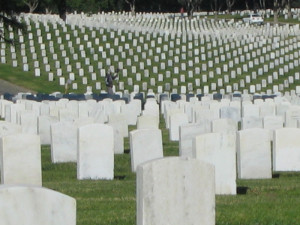
The Jenicke’s were thoughtful enough to have placed the tombstones face down. As disrespectful and offensive as this all sounded, the story became more outrageous when Humbert interviewed one of Tami’s bosses, Carole Turner with the Office of Veterans Services. “It would appear that the possibility is very, very strong that they are gravestones,” said Carole Turner before adding, with a smirk, “We are taking this very seriously and we will leave no stone unturned.”
That smirk may have been wiped off Turner’s face when the Attorney General’s Office launched an investigation of the Jenicke’s several days later. In the I-Team’s follow-up segment, Turner makes a return appearance where it’s revealed that she’s the VA’s district director. Speaking in platitudes, Turner gives the impression that she thought veterans were buried under the patio.
“We have to step back and say, ‘How have we failed?’” Turner told Humbert. “Our veterans deserve a respectful, peaceful final resting place.”
Actually, veterans’ tombstones deserve respect too. That would logically lead to including those veterans’ headstones that are making their way to the surface as the West LA VA biomedical nuclear and chemical dump’s hillside dirt erodes around them. It would seem likely that there would be more than ten atomic tombstones. EnviroReporter.com has obtained a photograph, circa 1971, that shows a huge load of rubble, and what appear to be tombstones, being dumped exactly where the debris is located today dotted with the grave markers.
To get all the tombstones out of this debris-strewn hillside of the dump would require considerable effort. That effort would be complicated by the fact that the veterans’ grave markers are buried in a toxic waste site which could possibly require excavators to wear hazardous materials protective outfits and masks.
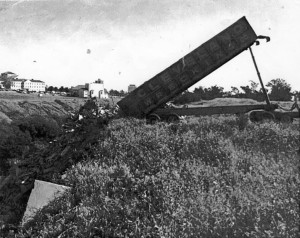
Ironically, considering that it lies partially under Barrington Dog Park, half the known dump is made up of the irradiated carcasses of animals killed in Cold War era experimentation at UCLA and the VA. Most of the animals were dogs with beagles being the preferred breed because of their agreeability.
While there is currently no evidence that human remains are in the dump, the VA and UCLA once participated in extensive human radiation testing and did have to contend with proper burial. As we wrote in “Where the Bodies are Buried,” records gleaned from the 1982 FOIA request to the VA indicate one 1964 meeting of the VA Center Radioisotope Committee that discussed “safe handling of cadavers containing radioactive isotopes.” The committee’s conclusions were blacked out by FOIA censors.
Other parts of this FOIA were blacked out but with an explanation. In a 1982 letter from the federal district counsel to the Los Angeles Federation of Scientists, which had submitted the FOIA request, the government wrote: “That information was withheld on the basis of potential employee misconduct leading to a civil and/or criminal investigation.”
Bodies or no bodies, nothing prepared us for the emotions that accompanied finding the VA’s atomic tombstones. The first impression was that they were graves but upon closer inspection it was clear they were dumped. A wave of sadness swept over me when thinking, “What if it were Pops?” My father Leo, a World War II Army veteran of the Pacific Theater, is buried at the Fort Rosecrans National Cemetery in San Diego. The dull throb of loss gave way to incredulity – how could this happen and where did these tombstones come from?’
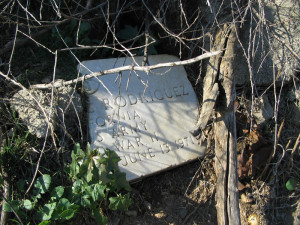
The wife of the man, whose surname was “Rodriquez”, had died. The VA cut a new tombstone, which I saw on the grave. But instead of destroying the old headstone, Rodriquez’s marble marker ended up dumped in the same ravine the VA had been dumping biomedical nuclear and chemical waste for twenty years.
This is not the only place tombstones were dumped on VA land. In one January 2000 document, the firm URS Greiner Woodward Clyde reported to the VA that headstones were found along with hospital syringes when building the drainage system for Brentwood School’s athletic fields.
Another piece of a tombstone was found embedded in the top of a mound in the dump that the VA said contained biomedical wastes from the excavation of Brentwood School’s athletic fields.
This broken tombstone piece imparts just part of an unknown soldier’s life. He was in the US Navy in World War I and died in January of an unknown year. That’s all that chunk of somebody’s life will tell.
There are pieces of veterans’ lives scattered on, and in, the hillside and a mound of Brentwood’s nuclear and chemical dump. Should the VA actually take the atomic tombstones out of the dump, it will mark the first time the VA has excavated in this troubled land that EnviroReporter.com and the LA Weekly continue to investigate.
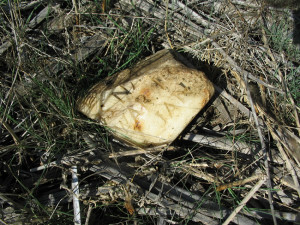












My mother found the article about the Jenicke’s stealing the veteran’s headstones and using them for their patio. She was horrified and showed the article to me. I felt nauseated. She and my father were both World War II U.S. Marines. It hit me especially hard because she was so ill at the time she learned of this, and she died last September. I can say that I am proud to have had her for my mother, and I buried her in a veteran’s section by my dear U.S. Marine father from WWII. I am thinking of moving her and Dad out of the veterans section and taking the headstones and moving to a totally private place so such cold-hearted activity can not insult my parents. Something is REALLY perverted, hateful, COLD HEARTED, and bitter about people who do such things. They are to be pitied and avoided.
As a veteran of WWII, I was disappointed to learn of the way in which these tombstones were treated. I wish to complement you on the excellent coverage of this story.
I have no understanding of how people can be so cold and thoughtless.
I can only hope those patio gravestones will be returned.
Thank you, Michael, for bringing this to our attention
How twisted things have become, that a young persons printed disgust over the disrespectful handling of Veteran grave stones elates Veteran advocates.
Ironically, this WLA VA prides itself on its cemetary with new sod and its treatment for the dead Veterans. What the VA does not want to realize is the best way to honor a dead Veteran is to take care of the living Veteran. Living Veteran patients at the VA, WLA, facility are like living grave stones and leasing out the Veterans Garden to a non-Veteran, non-profit entity (as recent as a month ago) is the equivelent of discarding old grave stones for new sod.
Feinstein, Waxman, Rosenthal and other electeds know about this “Land-grab” and stay silent ($$$$$$$$$).
Thank you for caring enough to expose this.
This is another great story by Michael Collins. What an insult to those soldiers to have their original markers thrown in a nuclear waste dump, of all things. Probably saved a little money. But to pave a patio and walk on them–some heads should roll on this.
The VA needs to be monitered. This is just one example of the mismanagement of our tax money.
OK, the granite marker for a grave is going to be replaced for whatever reason. However, that slab is 2 to 3 inches thick and I would think the surface could be re ground down the letterings 1/4 inch depth to erase the information and than re-used. It is called “re-cycling”.
Thank you for the reporting on this.
It’s sad to see graveyards that are not taken care of. I don’t understand why the gravestones were dumped.